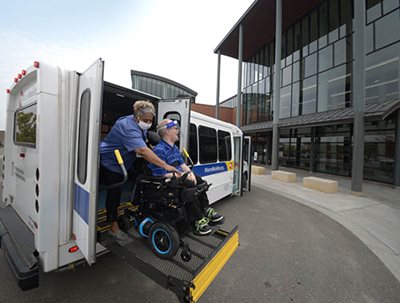
Online booking and new vehicle tracking capabilities improve customer experience
The Metropolitan Council responded to a pandemic-induced ridership downturn with a renewed sense of purpose to serve the needs of its Metro Mobility customers in 2021. The Council developed and introduced new customer-facing technologies, updated and enforced protracted safety measures, and implemented innovative hiring and retention strategies to try to curb a labor shortage. As a result, Metro Mobility ridership and performance metrics for 2021 vastly exceeded levels from the previous year.
Transitioning back to core services and customers
After nearly 363,000 free rides for healthcare workers and 25,000 food shelf deliveries to preserve jobs and support the economy during the first year of the pandemic, the Met Council returned to more normal operations in the second half of 2021, reprioritizing certified riders with disabilities.
The Met Council has projected Metro Mobility ridership to surpass 1.9 million certified rides for 2021, marking a 36% increase from 2020 and about 80% of pre-pandemic levels. (Final numbers will be available by early February.) Contractors consistently delivered strong service quality, with on-time performance, appointment times, and on-board time metrics exceeding contracted and Federal Transit Administration key performance requirements.
“Metro Mobility ridership was really quick in coming back after shutdown restrictions were lifted,” said Christine Kuennen, senior manager of Metro Mobility. “It’s a testament to the hardworking Metro Mobility staff and contactors who used collaboration, communication, and creative problem-solving to help us return and deliver the high service levels our community expects and deserves.”

Using technology to improve the rider experience
Metro Mobility developed and launched a wide range of technology advancements in 2021 to improve service levels and system efficiency for customers, contractors, and employees, including:
- A new online booking platform enables customers to book service and track assigned vehicles in moments and bypass the phone reservation system. More than 19,000 customers used the new platform in its first eight months of operation.
- In a partnership with our current taxi provider, Transportation Plus, Metro Mobility launched a customized iHail mobile booking application to support its Premium on Demand taxi service. Customers can register, book, and track rides — and receive $15 subsidies — through the convenience of their iOS or Android smartphones or tablets.
- A new interactive, web-based incident reporting module simplifies how contractors and Met Council employees document and track in-service incidents. The Met Council IT team modified an existing online tool used by Environmental Services to significantly reduce developmental costs.
Keeping our customers and crews safe
Safety comes first — especially in the middle of a pandemic. Metro Mobility implemented and maintains a wide range of safety measures to help keep operators and customers safe, including:
- Mandated masks for operators and riders (disposable masks provided)
- Vaccine and test mandates for operators
- Extensive fleet cleaning and sanitizing procedures
- Modified escort policies to maintain safe distancing
- Alternative service — in partnership with contracted taxi providers — to ensure COVID-19-affected customers have access to medical support
“Safety remains a top priority,” said Kuennen. “Our contracted drivers, management teams, customer service staff, and project administrators have worked tirelessly to respond to rapidly changing information, conditions, and updated requirements to meet our customers’ service and safety expectations.”

Battling widespread workforce shortages
Virtually every transportation provider in the country fought labor shortage challenges in 2021. Metro Mobility is working hard to reverse the trend. Facing a 39% decline in year-over-year hiring on large contracts, Metro Mobility collaborated with contractors to be more aggressive in recruitment and retention strategies, including exploring ways to increase hourly contracted rates.
“Metro Mobility ended the year approximately 10% short of its ideal workforce,” said Kuennen. “If we can’t reverse the trend, it’s going to be increasingly difficult to meet on-time performance demands.”
Metro Mobility resources